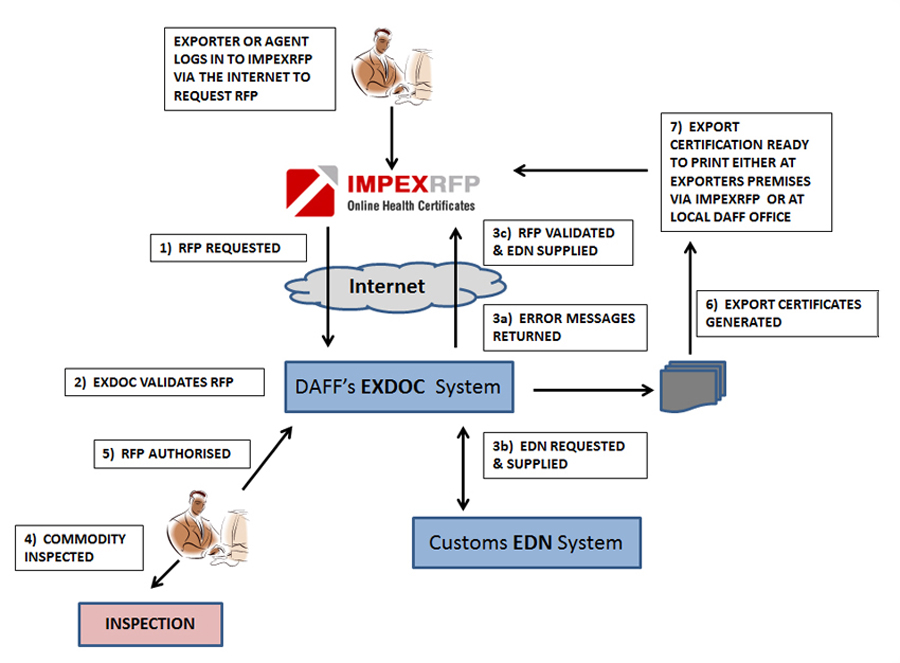EXDOC Process
The following is a high level overview of the EXDOC process:
1) Exporter or their agent submit the message to EXDOC by login in to the ImpexRFP web based application through any internet browser.
2) EXDOC validates the message.
3) EXDOC then does the following:
a) EXDOC sends back an error message if any errors are detected during the validation process.
b) EXDOC communicates with Australian Customs Service (ACS) and obtains an Export Declaration Number (EDN) if requested by the Exporter/Agent.
c) EXDOC sends a validated Request For Permit (RFP) (and EDN if requested) back to ImpexRFP.
4) Department of Agriculture, Fisheries & Forestry (DAFF) Biosecurity Officer inspects the commodity.
5) DAFF Biosecurity Officer accesses EXDOC and Authorises the RFP.
6) EXDOC generates a Phytosanitary/Health certificate (and other requested export certification if requested).
7) EXDOC sends a message to ImpexRFP advising that the certification is ready to print. The Certificate can be printed either at Exporter’s premises or at the local DAFF office.
The ability to incrementally add data means an RFP may undergo a number of status changes, in particular with respect to status of inspection and production of export documentation. The possible RFP statuses are given below:
Click here to view the RFP Status Transition Diagram
| ORDR (Order) | The RFP does not necessarily have the basic information sufficient to allow DAFF Biosecurity inspection, but the Exporter has requested either an RFP number to be reserved by EXDOC or an EDN number to be allocated by Customs. The RFP need only have the exporter reference details and may include any other RFP information including Australian Customs data.Note: RFPs of this status cannot be accepted for the purpose of inspection or notification of intention to export |
| INIT (Initial) | The RFP has basic information sufficient to allow DAFF Biosecurity inspection. The product is fully described for inspection purposes, but not necessarily in sufficient detail for inclusion on a Certificate, and consignee and shipment details may not be present. The product has not yet been authorised by DAFF Biosecurity. |
| FINL (Final) | The RFP has full information to allow both DAFF Biosecurity inspection and generation of Certificates. The product is fully described, and full consignee and shipment details are present. The product has not yet been authorised by DAFF Biosecurity. |
| INSP (Inspected & Authorized) | The RFP has been authorised by DAFF Biosecurity. It has all the information necessary for inspection, and now includes the results of successful inspection; Export Permit Number (EPN), inspector comments and container seal numbers if appropriate. It does not have sufficient information to enable the generation of Certificates, ie consignee or shipment details. |
| HCRD (Health Certificate Ready) | The RFP has been authorised by DAFF Biosecurity. It has full details of product and inspection, including EPN, and sufficient information to allow generation of Certificates. Certificates have not yet been generated. |
| COMP (Completed) | Certificates have been generated if required. The RFP has full details of product, inspection and certification. |
| As well as the above, the status of the RFP may also be extended to one of the following: | |
| SUSP (Suspended) | An RFP may be suspended before Certificates are generated if there is a problem with the product that must be fixed before export can occur. A suspended RFP can be reinstated subsequently to its previous status. |
| CANC (Cancelled) | An RFP may be cancelled if:
A cancelled RFP cannot be re-instated or amended in any way. |








